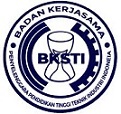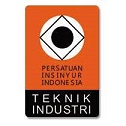The Effect of Fly Ash Substitution in 3 Brands of PCC Cement on The Compressive Strength f Concrete
Abstract
Fly ash, a by-product of coal combustion in thermal power plants is utilized as a substitute for Portland Cement in concrete due to its pozzolanic properties. Mainly, class F fly ash—produced from the combustion of anthracite coal at approximately 1560˚C (according to SK SNI S15-1990-F)—contains less than 10% lime (CaO) and exhibits significant pozzolanic or filler properties. This research investigates the impact of varying fly ash proportions (0%, 10%, 15%, and 20%) on the compressive strength of concrete. The experimental setup included 108 cylindrical test specimens (10 cm in diameter and 20 cm in height), representing different brands of cement and fly ash mixtures, tested at 7, 14, and 28 days. The study was conducted at PT. Waskita Beton Precast Plant in Sadang, Purwakarta, West Java, targeting a concrete compressive strength of 40 MPa. Results indicate that at 0% fly ash, the compressive strength using Garuda Cement reached 76.66 MPa after 28 days. However, this strength decreased with increasing fly ash content, measuring 72.35 MPa, 69.07 MPa, and 68.13 MPa for 10%, 15%, and 20% fly ash, respectively. These findings highlight the influence of fly ash content on the structural integrity of concrete, suggesting a potential trade-off between sustainability and mechanical performance.
Keyword: Fly Ash, Compressive Strength of Concrete, Portland Cement
Full Text:
PDFReferences
X.Wang, “Development of water retentive and thermal resistant cement concrete and cooling effects evaluation,” Materials (Basel)., vol. 14, no. 20, 2021, doi: 10.3390/ma14206141.
H.Tariq, “Mechanical Performance of Polymeric ARGF-Based Fly Ash-Concrete Composites: A Study for Eco-Friendly Circular Economy Application,” Polymers (Basel)., vol. 14, no. 9, 2022, doi: 10.3390/polym14091774.
C.Luan, “Practical prediction models of tensile strength and reinforcement-concrete bond strength of low-calcium fly ash geopolymer concrete,” Polymers (Basel)., vol. 13, no. 6, 2021, doi: 10.3390/polym13060875.
A.Maryoto, “Effect of calcium stearate in the mechanical and physical properties of concrete with pcc and fly ash as binders,” Materials (Basel)., vol. 13, no. 6, 2020, doi: 10.3390/ma13061394.
S.Permatasari, “Pengaruh Bahan Tambah Batu Bata Merah Terhadap Kuat Tekan Beton Fcâ€Tm 21 Menggunakan Agregat Kasar Pt. Amr Dan Agregat Halus Desa Sunggup Kota Baru,” Tapak (Teknologi Apl. Konstr. J. Progr. Stud. Tek. Sipil, vol. 8, no. 2, pp. 155–161, 2019.
L.Rumiyanti, “Optimization of using Baturaja fly ash as a Portland Composite Cement (PCC) additive,” Journal of Physics: Conference Series, vol. 1572, no. 1. 2020. doi: 10.1088/1742-6596/1572/1/012047.
S. R.Prusty, “Mechanical and micro-structural properties of blended fly Ash-slag based alkali activated concrete,” Mater. Today Proc., vol. 65, pp. 1748–1754, 2022, doi: 10.1016/j.matpr.2022.04.795.
A. K.Sinha, “Mechanical and bond behaviour of high volume Ultrafine-slag blended fly ash based alkali activated concrete,” Constr. Build. Mater., vol. 383, 2023, doi: 10.1016/j.conbuildmat.2023.131368.
K.Ohenoja, “Utilization of fly ashes from fluidized bed combustion: A review,” Sustain., vol. 12, no. 7, 2020, doi: 10.3390/su12072988.
R.Rajiman andI.Aulia, “Pengaruh Penambahan Serbuk Batu Basalt Pada Komposisi Campuran Beton Menggunakan Ordinary Portland Cement (Opc) Ditinjau Dari Kuat Tekan Beton,” Tapak (Teknologi Apl. Konstr. J. Progr. Stud. Tek. Sipil, vol. 9, no. 1, pp. 9–17, 2019.
R.Damayanti, “Abu batubara dan pemanfaatannya: Tinjauan teknis karakteristik secara kimia dan toksikologinya,” J. Teknol. Miner. dan Batubara, vol. 14, no. 3, pp. 213–231, 2018.
A.Maryoto, “The Setting Time of Portland Composite Cement Mixed with Calcium Stearate,” Lecture Notes in Civil Engineering, vol. 225. pp. 1119–1132, 2023. doi: 10.1007/978-981-16-9348-9_99.
A. S.Oestergaard, “Musculoskeletal disorders and perceived physical work demands among offshore wind industry technicians across different turbine sizes: A cross-sectional study,” Int. J. Ind. Ergon., vol. 88, 2022, doi: 10.1016/j.ergon.2022.103278.
R. R.Nur, F. D.Hartanti, andJ. P.Sutikno, “Studi awal desain pabrik semen portland dengan waste paper sludge ash sebagai bahan baku alternatif,” J. Tek. ITS, vol. 4, no. 2, pp. F164–F168, 2016.
P.Jani, “Class C fly ash-based alkali activated cement as a potential alternative cement for CO2 storage applications,” J. Pet. Sci. Eng., vol. 201, 2021, doi: 10.1016/j.petrol.2021.108408.
Y.Kocak, “Effects of metakaolin on the hydration development of Portland–composite cement,” J. Build. Eng., vol. 31, 2020, doi: 10.1016/j.jobe.2020.101419.
M. R. A.Rozaq andN. A.Mahbubah, “Efisiensi Persediaan Kantong Semen Berbasis Metode MIN-MAX, EOQ, dan TWO-BIN di Packing Plant PT AKA,” Sigma Tek., vol. 5, no. 2, pp. 259–266, 2022, doi: 10.33373/sigmateknika.v5i2.4637.
A.Sahputra, “Pengaruh Limbah Bahan Bakar Batu–Bara (Bottom Ash) sebagai Bahan Tambah Agregat Halus pada Campuran Beton.” 2015.
Y.Du, “Flexural behavior of alkali-activated slag-based concrete beams,” Eng. Struct., vol. 229, 2021, doi: 10.1016/j.engstruct.2020.111644.
O.Xu, “Experimental investigation surface abrasion resistance and surface frost resistance of concrete pavement incorporating fly ash and slag,” Int. J. Pavement Eng., vol. 22, no. 14, pp. 1858–1866, 2021, doi: 10.1080/10298436.2020.1726348.
P.Azarsa, “Comparative study involving effect of curing regime on elastic modulus of geopolymer concrete,” Buildings, vol. 10, no. 6. 2020. doi: 10.3390/BUILDINGS10060101.
W.Guo, “Mechanical properties and compressive constitutive relation of solid waste-based concrete activated by soda residue-carbide slag,” Constr. Build. Mater., vol. 333, 2022, doi: 10.1016/j.conbuildmat.2022.127352.
P.Azarsa, “Durability and leach-ability evaluation of K-based geopolymer concrete in real environmental conditions,” Case Stud. Constr. Mater., vol. 13, 2020, doi: 10.1016/j.cscm.2020.e00366.
B.Baten, “Combined effect of binder type and target mix-design parameters in delaying corrosion initiation time of concrete,” Constr. Build. Mater., vol. 242, 2020, doi: 10.1016/j.conbuildmat.2020.118003.
M.Mulyadi, “Riset desain dalam metodologi penelitian,” J. Stud. Komun. Dan Media, vol. 16, no. 1, pp. 71–80, 2012.
DOI: http://dx.doi.org/10.24014/jti.v10i1.25829
Refbacks
- There are currently no refbacks.
Copyright (c) 2024 Zulfikar Jati Aliansyah, Firdaus Firdaus

This work is licensed under a Creative Commons Attribution-NonCommercial-ShareAlike 4.0 International License.
Jurnal Teknik Industri
P-ISSN 2460-898X | E-ISSN 2714-6235
Published by:
Industrial Engineering Department
Universitas Islam Negeri Sultan Syarif Kasim Riau, Indonesia
Office Address:
H.R. Soebrantas KM 15.5, Tampan, Pekanbaru, Riau, Indonesia 28293
email: jti.fst@uin-suska.ac.id
Indexed by:
JTI : Jurnal Teknik Industri under a Creative Commons Attribution-NonCommercial-ShareAlike 4.0 International License.

















